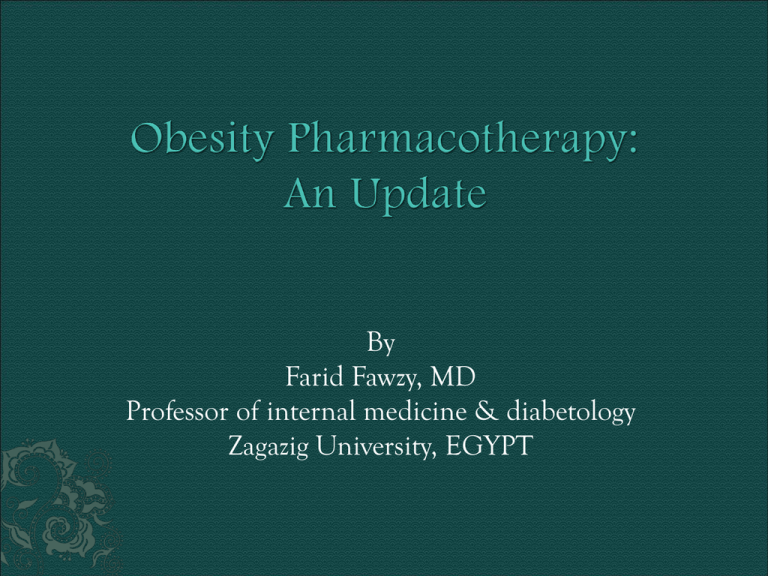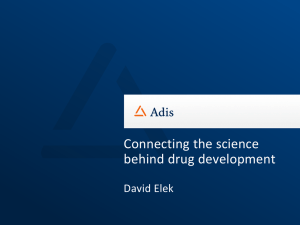Obesity Pharmacotherapy - The 6th Arab Diabetes Forum In
advertisement

By Farid Fawzy, MD Professor of internal medicine & diabetology Zagazig University, EGYPT Obesity in the US and other industrialized nations is now considered an epidemic. Estimates of the prevalence of obesity vary. Earlier estimates suggested that over 20% of adults in Europe and the US were obese More recent reports suggest that approximately 50 to over 60% of adults in the US are overweight or obese According to the International Obesity Task Force, obesity is defined as a body mass index (BMI) ≥ 30 kg/m2 Patients meeting this criterion for obesity have a significantly increased risk of numerous morbidities Obesity is mainly linked to the cardio-metabolic risk This cardio-metabolic risk is best represented in the metabolic syndrome A harmonized definition produced by NHLBI, IDF, AHA, IAA, IASO is: Current Approaches to Obesity Management Treating obesity is often frustrating: - Limited success of diet & lifestyle interventions - Limited number of effective and well tolerated pharmacologic therapies available - Negative attitude of patients: wrong beliefs of a hormonal or yet undiagnosed cause, noncompliance,….etc - Lack of time - Lack of expertise. Exclude potential secondary causes Diet and lifestyle interventions Behavioral modifications Drug treatment Bariatric surgery Drugs that primarily decrease appetite or increase satiety - Sibutramine - Benzphetamine - Phendimetrazine - Mazindol - Diethylpropion (amfepramone) Drugs that ↑RMR and thermogenesis and ↓ appetite - Dextroamphetamine # - Caffeine - Phentermine - Ephedrine Drugs acting in the gastrointestinal tract - Orlistat The mechanism of action is through an increase in the availability of anorexigenic CNS neurotransmitters such as: - Norepinephrine - Serotonin - Dopamine - Combination of these. Sympathetic amines Rarely used for the treatment of obesity. Suppress appetite, and increase metabolic rate. As a result of their stimulant effect, they may cause dangerous cardiovascular adverse effects such as tachycardia and hypertension. They also have high abuse potential and are therefore considered a schedule II drug. Dextroamphetamine (Dexedrine,Dextrostat,Procentra) does have an indication for treatment of narcolepsy and attention deficit hyperactivity disorder, but no specific indication for the treatment of obesity. Includes Benzphetamine (Direx) and Phendimetrazine (Bontril)) Both are US DEA Schedule III anorectic sympathomimetic amines Pharmacologic activity similar to the amphetamines FDA-approved for short-term treatment of obesity. Include: - Mazindol (Mazanor) - Amfepramone (Adipex, Adipost, Tenuate) - Phentermine (Oby-cap, T-diet, Zantryl) DEA Schedule IV sympathomimetic amines Primarily decrease appetite, but they may have some potential to increase metabolic rate. These drugs have less stimulant activity than amphetamines and low abuse potential, Indicated for short-term treatment of obesity (for only a few weeks, up to 12 weeks). Among their potential adverse effects are cardiovascular effects that include cardiac dysrhythmias, tachycardia, and edema. If effective non-amphetamine symathomimetic amines result in only modest body weight reduction and usually for only a few weeks. These agents are contraindicated in patients with cardiovascular conditions such as advanced arteriosclerosis, symptomatic cardiovascular disease, and moderate to severe hypertension. Given these potential adverse effects and the fact that for the vast majority of patients obesity requires lifelong treatment, the health benefits of using these anorexiants for only a few weeks in the treatment of a lifelong condition is questionable. Thus, these drugs are not widely prescribed for the treatment of obesity in the US. Another over-the-counter noradrenergic agent phenylpropanolamine (Accutrim) was withdrawn from the US market in 2000 because of unacceptable risks of stroke especially in adult women. Fluoxetine is a highly selective serotonin reuptake inhibitor (SSRI) that may decrease appetite. Definitive and significant bodyweight loss has been reported inconsistently in clinical trials. Trials of other drugs such as bupropion and sertraline have yet to demonstrate definitive, longterm efficacy in the treatment of obesity Fluoxetine, bupropion and sertraline have not received FDA approval for the treatment of obesity. Sibutramine inhibits serotonin and norepinephrine reuptake Approved by the FDA for the treatment of obesity. Acts primarily through increasing satiety, although there may be some stimulation of thermogenesis by activating β-adrenoceptors in brown adipose tissue. Controlled studies have demonstrated that bodyweight loss occurs for the first 6 months of treatment with sibutramine and is maintained for up to 1.5 years afterwards. Bodyweight gain frequently recurs after discontinuation of this drug. Sibutramine treatment have also demonstrated improvement in important cardiovascular risk factors, such as blood lipid levels, and glucose metabolism Potential cardiovascular adverse effects of sibutramine include mild increases in blood pressure and heart rate. Other adverse effects include dry mouth, insomnia, and constipation. Of most concern is that some patients may experience substantial increases in blood pressure with sibutramine, and thus close monitoring is required. Sibutramine is contraindicated in patients with uncontrolled hypertension, CHD, cardiac dysrhythmias, congestive heart failure, or stroke. Ephedrine and caffeine are commonly used in combination over-the-counter bodyweight loss preparations. They may also have appetite suppressant and thermogenic properties. However,these effects are short lived (weeks), and adverse effects may include tremor, insomnia, and cardiac dysrhythmias. Orlistat is a gastrointestinal lipase inhibitor that impairs the absorption of dietary fat. Significant and sustained bodyweight reduction for at least 2 years has been noted in clinical trials CHD risk factors have been shown to improve as well. Orlistat initially was evaluated as a hypolipidemic agent, since lipid blood levels improve with orlistat treatment beyond bodyweight loss alone. Orlistat treatment may also favorably affect glucose metabolism in obese pre-diabetics and in patients with type 2 diabetes mellitus. High blood pressure may be improved as well. Gastrointestinal adverse effects such as flatus, oily stools, fecal urgency and fecal incontinence. Abdominal pain particularly among patients who do not comply with the recommended low fat diet. Malabsorption of fat-soluble vitamins (A, D, E, and K) has rarely, if ever, occurred, but a daily multivitamin in the evening is recommended concurrently with orlistat treatment as a preventative measure. Antiobesity Drugs in Development A reduction in caloric intake will continue to be a mainstay of treatment of patients with obesity who have been unresponsive to diet, exercise, and behavior modification One cannabinoid (CB) receptor antagonist ,rimonabant, is in phase III clinical trial Rimonabant blocks the CB1 receptor, which is found throughout the CNS. The endogenous CB system may be involved with a number of CNS functions, including appetite. Blocking or antagonizing these functions may result in bodyweight reduction. Another antiobesity drug in phase III of development CNTF is a nerve growth factor (cytokine) that is not found in appreciable amounts in blood but is released locally in the hypothalamus. It was originally studied as a potential treatment for amyotrophic lateral sclerosis (ALS). It did not demonstrate efficacy in patients with ALS, however bodyweight reduction was observed. An extract from a cactus that reportedly has been eaten by African tribesmen in order to decrease hunger during long hunting trips. Clinical trials are planned to determine its safety and effectiveness in the treatment of obesity. Dopamine receptor antagonists may also reduce appetite and thus caloric intake. For example, risperidone was shown to result in bodyweight reduction in a very small trial involving treatment of patients with Prader-Willi syndrome Ecopipam, a dopamine (D1) receptor antagonist, was originally developed as atreatment for schizophrenia. It has recently been withdrawn from clinical trials with regard to treatment of obesity. Selective 5-HT2C receptor agonists are being evaluated as antiobesity drugs because they are thought to induce satiety. The selectivity of these newer potential agents may have an advantage over older antiobesity drugs which acted non-specifically on the serotonergic system. For example, dexfenfluramine, withdrawn from the market because of associated heart valve abnormalities, indirectly resulted in the indiscriminate activity of 5-HT receptors, including those in peripheral tissue. Activation of 5-HT2B receptors accounted for the fenfluramine-associated valvular heart disease. In contrast, the distribution of 5-HT2C receptors i.e., expressed in high density in the brain (notably in the hypothalamus) but absent or few in peripheral tissues, indicates that selective 2C receptor agonists may not have adverse effects related to peripheral 5-HT receptor activation. At least one trial has suggested that topiramate, originally intended as an antiepileptic drug, may be beneficial in treating binge-eating disorder Other dopamine and norepinephrine reuptake inhibitors are also in development. However, the current clinical obesity trial program with topiramate has been discontinued. Other potential antiobesity drugs in development included melancortin-4-receptor (MC4R) agonists and neuropeptide Y antagonists. Anti-obesity Drugs that Predominantly Increase Metabolic Rate or Thermogenesis Other anti-obesity drugs in development may increase resting metabolic rate or thermogenesis. This is important because for most people approximately two-thirds of the body’s energy expenditure is a result of maintaining essential body functions and body temperature. Therefore, in the event that exercise is not sufficient, drugs that increase energy expenditure might hold promise for bodyweight reduction. Adipocyte complement-related protein of 30kD (Acrp30) has been shown to result in bodyweight loss in mice by increasing fatty acid oxidation in muscle. β3-Adrenoceptors, located mainly in adipose tissue, are thought to be involved in lipolysis and thermogenesis. Selective β-3 adrenoceptor agonists may therefore theoretically increase metabolic rate and decrease body fat. Thyroid hormone preparations have been evaluated in the treatment of obesity since 1900. Because of possible hyperthyroidism and potential acceleration of osteoporosis, thyroid hormone is contraindicated as atreatment for obesity However, thyroid hormone does increase thermogenesis, and antiobesity drugs in development include agents that target certain actions at the thyroid hormone receptor level. Drugs that May Decrease Appetite/Increase Satiety and Increase Metabolic Rate/Thermogenesis Other potential drug treatments, such as leptin may both reduce appetite/ increase satiety and increase energy expenditure. Because leptin is produced by fat cells and regulates food intake and energy expenditure, it was hoped that administration of recombinant leptin would result in bodyweight loss. However, its physiological effects are complex, and clinical trials have shown conflicting results Phase II trials with ‘second-generation’ leptin are currently ongoing in the hopes of demonstrating superior efficacy compared with native leptin. For example, some studies suggest that, in contrast to rodents, no relationship has been found between blood leptin levels and energy expenditure in humans. Future studies of ‘second generation’ leptin may help further illuminate the role of leptin in human energy expenditure. Antiobesity Drugs that Predominantly Affect the Gastrointestinal System Other potential antiobesity drugs may act directly on the gastrointestinal system (GI) A potential substance is Cholecystokinin-A (CCK-A) promoter, a gut hormone produced in the upper small intestine It activates gastric fibers and causes satiety CCK-A agonists may conceivably prove to be a useful treatment for obesity. Glucagon-like peptide–1 (GLP-1) is a gut hormone that inhibits glucagon secretion and stimulates glucoseinduced insulin secretion. It may therefore reduce blood glucose levels in patients with diabetes mellitus and may inhibit gastric emptying GLP-1 is also one of a number of hormones that signals satiety and thus bodyweight loss may also occur through this additional mechanism. Other GI-acting antiobesity drugs include: - lipase inhibitors, which are thought to work similarly to the current lipase inhibitor, orlistat - phytostanols which impair cholesterol absorption among other properties - Ghrelin antagonists. Ghrelin is an endogenous ligand for the growth hormone secretagogue receptor secreted by the stomach May account for the observed increased appetite after dieting. Inhibition of this hormone may be a potential target in the treatment of obesity, and specially weight regain Other drugs in development, such as growth hormone fragments, may have potential favorable effects upon obesity. Growth hormone, given to patients with growth hormone deficiency, results in an increase in lean body mass and a reduction in fat mass The use of growth hormone fragment in patients with obesity without absolute growth hormone deficiency may also hold promise in improving body composition. Drugs that increase insulin sensitivity or otherwise affect insulin metabolism may be effective in treating obesity These include protein tyrosine phosphate drugs, peroxisome proliferation activator gamma receptor antagonists, short-acting bromocriptine, carboxypeptidase inhibitors, and somatostatin agonists. Hyperinsulinemia is often associated with early stages of obesity and may worsen insulin resistance in skeletal muscle while adipose tissue remains insulin sensitive. This often results in the ‘obesity metabolic cycle’ where hyperinsulinemia is followed by worsening insulin resistance, followed by even greater hyperinsulinemia. Correction of this cycle might reasonably be expected to improve consequences of the obesity metabolic cycle. Drugs that primarily decrease appetite or increase satiety Ciliary neurotrophic factor Cannabinoid (CB1) receptor antagonist (rimonabant) P57 Dopamine antagonist (risperidone) Selective 5-HT2C receptor agonists Topiramate Dopamine and norepinephrine reuptake inhibitors Melanocortin-4 receptor (MC4R) agonists Neuropeptide Y antagonists Drugs that primarily increase RMR or thermogenesis Adipocyte complement – related protein of 30kD (Acrp30) β-3 adrenergic receptor stimulators (β-agonists) Thyroid receptor agonists Drugs that increase RMR and thermogenesis and decrease appetite ‘Second-generation’ leptin Gastrointestinal-acting drugs Cholecystokinin-A promoter (CCK-A promoter) Glucagon-like peptide–1 (GLP-1) Lipase inhibitor Phytostanol Ghrelin antagonists Other Growth hormone fragment Insulin sensitizers (protein tyrosine phosphatase drugs, peroxisome proliferation activator gamma receptor antagonists, short-acting bromocriptine, carboxypeptidase inhibitors, somatostatin agonists) Address obesity therapy in a manner similar to other metabolic diseases Education and behavior modification can be an effective first step If these non-pharmacologic interventions fail, then consider drug treatment Drug treatment is indicated in patients with comorbidities and a BMI ≥27 kg/m2 or in those with BMI ≥30 with or without co-morbidities. Here are the outcomes. Coronary events actually looked higher in sibutramine. All cause mortality, not influenced. Obesity results from an imbalance between caloric consumption and energy expenditure. Obesity may result in significant morbidity alone, and may cause or exacerbate important co-morbidities such as cardiovascular risk factors. The treatment approach to patients with obesity includes: dietary counseling education routine physical exercise behavior modification if needed, drug treatment. Sibutramine and orlistat are currently available for the treatment of obesity Antiobesity drugs in development include agents that decrease appetite, increase satiety, and increase energy expenditure. Other potential antiobesity drugs are recombinant gut hormones that may result in bodyweight loss through their physiological actions locally at the gut or in the CNS. Insulin sensitizing drugs are being developed to address the ‘obesity metabolic cycle. Other hormones, like growth hormone fragments may work to favorably alter body composition It is to be expected that once more antiobesity drugs become available, agents with different mechanisms of action may be used in combination, as is currently accepted for the treatment of other metabolic conditions such as dyslipidemia, hypertension, and type 2 diabetes mellitus.







